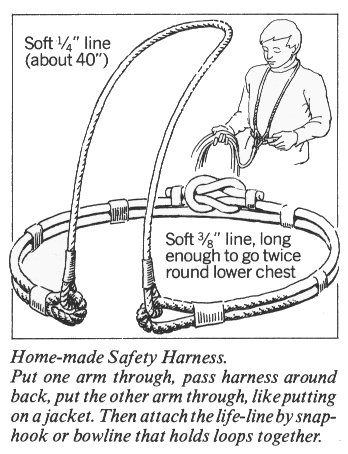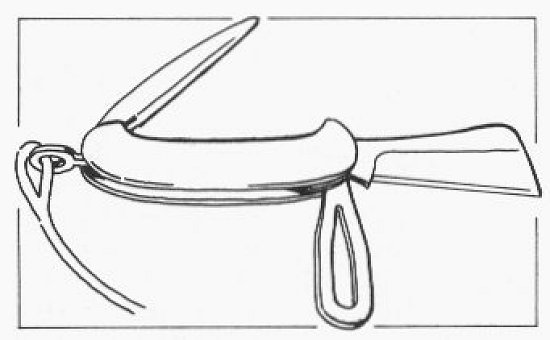Chapter
3
Equipment
Legal Requirements
These vary
from time
to time and from place to place. Before cruising any area, you should
check
the local requirements.
- In Canada, contact the Canadian
Coast Guard at http://www.ccg-gcc.gc.ca/
- In the U.S., the requirements
may
vary from state
to state
A
brief summary of current
(2001) Canadian
legal requirements for Wayfarer-size dinghies is provided in the box
below:
...
Personal protection
equipment
- one approved personal
flotation device or lifejacket
of appropriate size for each person on board
- one buoyant heaving line
of
not less than 15
m in length
Boat safety equipment
- one manual propelling
device or
- an anchor with not less
than
15 m of cable, rope
or chain in any combination
- one Class 5BC fire
extinguisher, if the pleasure
craft is equipped with a fuelburning cooking, heating or refrigerating
appliance
- one bailer or one manual
water pump fitted with
or accompanied by sufficient hose to enable a person using the pump to
pump water from the bilge of the vessel over the side of the vessel.
Navigation equipment
- a sound signalling device
or
a sound signalling
appliance
- navigation lights that meet
the
applicable
standards set out in the Collision Regulations if the pleasure craft is
operated after sunset and before sunrise or in periods of restricted
visibility
Distress equipment
- Powered boats not more
than
6m in length (an
outboard motor on a Wayfarer) must carry distress equipment: a
watertight
flashlight or 3 Canadian approved flares of type A, B or
C
- A reminder from Dick
Harrington that the U.S.
Coast Guard is very "sticky" about its requirement "A
minimum of 3 approved and currently dated distress flares."
|
Lights and Horn. If you are
under
way after sunset running lights1
are required, i.e, red and green port and starboard lights,
and at
least a light to shine on the sails. If you ever anchor where anyone
might
be navigating at night, an anchor light1
(360°) must be hung in the rigging. We have a "man-overboard" light
that doubles as anchor light.
While
you are not required to carry
a fog
signal or bell at all times, if you should be out in fog, either
anchored,
adrift, or under way, you must have an "efficient means" of making a
noise.
A horn blown with your own breath is the most reliable. It is easily
stowed
in a clip on the hull or bulkhead and also comes in handy for
attracting
the attention of your companion boat or calling people for meals, etc.
You will need it if you are going to try to get a swing bridge to open
for you.
Radar
Reflectors. There are
quite strict
regulations regarding radar reflectors, but the requirements "need not
be met if they are not essential for the safety of the pleasure-craft,
or are impracticable". I presume therefore that you would not be
penalized
for not carrying one, but if you were run down by a commercial vessel,
you might have trouble with your insurance company if a radar reflector
could have prevented the collision. Carry a collapsible reflector,
ready
to be assembled and hoisted, in case you cannot avoid being in a
commercial
shipping lane in a fog or at night. It should give a big enough echo to
look like something that might dent a freighter. When assembled it is
essential
that the three reflecting planes are exactly at right angles2
and stay so while aloft. It should be flown in the oblique ("catch
rain")
position.
Equipment
that is not legally
required
but is advisable. Most of the following items are desirable or
essential
for a camping cruise depending upon the amount of open water you plan
to
cross and the conditions
you might encounter. A good deal less
would
be needed if you were going to make only a five-mile sail across the
bay.
- Oars.
Get the longest
oars
you can, as
the longer they are, the easier it is to row. The limitation on this
will
be convenient stowage, which usually has to be on the sole of a dinghy.
Oar-locks should be placed as far outboard as possible, and about 15
inches
aft of the centre thwart.
- Paddles.
Although oars
are
best for a
long haul, and essential if you have to pull against a current or a
strong
wind, a paddle is handier for manoeuvering to or from the dock, or in a
crowded anchorage. I also keep a paddle with a telescopic handle in one
of the closed buoyancy compartments, as a reserve in case of a capsize
and loss of gear.
- Anchors.
For a major
cruise
you need two
anchors. You will use both when riding out a strong blow, and you need
a reserve in the event of losing one, which can happen easily. A
cruising
sailor's attitude to anchors should be to take the heaviest he can
stow,
not the lightest he can get away with. As you are taking two, they may
as well be different types, for example, a Danforth or a CQR (plough)
for
a good holding bottom, and a grapnel for rock. I carry a nine-pound
Danforth
and an eight-pound grapnel, each with six feet of chain and 100 feet of
rope. The main function of the chain is to spare the rope from damage
on
rocks. Also it cushions the initial shock when the rope comes taut, and
it does not foul around the stock during a quiet evening.
- Ground
Tackle. The rope
should still be
thick enough to withstand a good deal of chafing. Use half or
three-eighths
inch synthetic rope although its tensile strength when new is above
what
is needed. Chafe (which of course should be guarded against) requires a
very large safety factor here. Such a quantity and weight of ground
tackle
seems ridiculous on a summer afternoon. It does not seem ridiculous
when
you are sleeping afloat in your tent and the wind picks up to gale
force,
whether you have a rocky shore or open lake in your lee. Wire all
shackle
pins. Splice the rope securely round the thimble, or, if you use an
anchor
bend or bowline, seize the end by whipping to the standing part. Always
leave the bitter end of the rode tied to the boat, and you are more
likely
to finish the cruise carrying the same two anchors you started with.
- Inflatable
Boat Rollers (1
or
2).
Boat rollers are invaluable for dragging a dinghy up the beach, and can
be carried inflated as extra buoyancy. Imagine the weight of one of
them
filled with water. This same force acts in reverse when filled with
air,
considerably increasing your boat's buoyancy. They must be securely
lashed
in position.
- Fenders.
The boat
rollers
can be used
as fenders, but they are expensive items to expose to damage. Also,
after
using them in this manner, you may forget to lash them securely when
you
sail away. It is probably better to buy separate fenders, or to parcel
up old life jackets if you have any. Never use your in-service life
jackets.
- Compass.
One mounted and
one
hand held
compass are required. Positions for mounting the boat's compass will be
discussed later, as this can be quite a problem.
- Sea
Anchor. A sea anchor
is
useful only
in a strong wind with heavy seas, and requires plenty of sea-room. A
drogue
of 18- or 24-inch diameter, with swivel, is usual. (You do not often
meet
anyone who has actually used one.)
- Bailers.
You need two
buckets tied to
the boat in addition to Elvstrom or transom bailers if fitted. Bucket
handles
must be rugged and securely fixed. One bucket with a well-fitting lid
is
handy to carry things that need to be kept dry.
- Bilge
Pump. A good
supplement to the essential
buckets is a small hand-held pump, with a suitable intake hose to slip
under the floorboards, and a discharge hose to go overside or into the
centreboard trunk.
- Safety
Harness and Life Line.
Many people
do not carry a safety harness, but to have one on and securely tied to
the boat may save your life. In the event of capsizing, the boat may
drift
faster downwind than you can swim, or if you fall overboard, big waves
might hide you from your crew. A lifeline is even more important for
the
skipper if the crew is not an experienced helmsman. Suppose the jib is
poled out, or spinnaker flying, when you fall overboard; the crew will
take a little time to stop the boat, let alone trim sails and beat back
to you single-handed. He might even forget the centreboard in the
stress
of the moment. It is better to have your life-line attached, then you
will
stay within shouting distance. You can buy a commercial harness, or you
can make one out of webbing or rope. Think carefully which is the
weakest
link (often a D-ring) and be sure it is strong enough. Test it by
hauling
yourself up with block and tackle. Metal parts ought not to distort at
all under your full weight.

- Life-line:
16-20 feet of
3/8-inch synthetic
rope tied with bowline or fisherman's bend to the centre thwart,
skipper
to starboard, crew to port, and always pass that way in the boat to
avoid
tangling. (N.B. I have had a bowline come undone while moving around
with
the line slack, using braided synthetic rope. This must not be allowed
to happen.)
- Water
Containers. For
ocean
sailing, a
supply aboard of fresh water is a vital necessity. Containers must be
securely
lashed, and protected from damage. Water is the most essential item of
stores. When sailing on fresh water, even polluted, you are never going
to die of thirst. Where the lake water is drinkable, you need carry
only
enough for 24-48 hours, which you may need at a campsite where the
local
water is unfit for drinking. Replenish your water containers when you
are
out on open water. In more populated areas, carry enough for three or
four
days, as not all places where you camp will have good water. Two or
three
smaller containers are better than one large one, for ease of handling.
- Flashlights
and Spare
Batteries.
Even
for a one-day sail, carry a flashlight. For a camping trip you need two
or more. The right-angled kind that clip on to the belt are very handy.
It is convenient to use the same size of battery for flashlights, radio
(if carried), running lights etc. Fewer spares need be carried this way.
- Whistles.
A whistle that
will not break
(and that has been tested when wet) should be carried by each person in
case he falls overboard, or gets lost or injured in the bush when
ashore.
- Knives.
Every sailor
should
carry a knife,
preferably with marlin-spike and shackler, for many everyday uses. Once
in a lifetime you may have to cut a line fast in emergency, so it
should
be sharp, always. (Also it is more useful that way, every day.)

1
According to Canadian Coast Guard Boating Handbook, these lights are
not
required by boats under 7 metres long; but a white light must be shown
in the direction of an approaching vessel "in time to prevent a
collision".
2
reflector with an inexact right angle, more than 2° off, is worse
than
a sheet of foil the same size.
|

